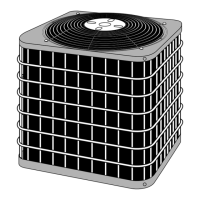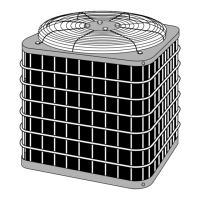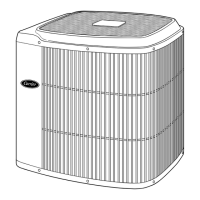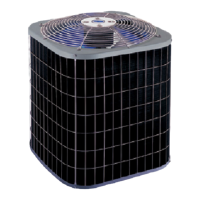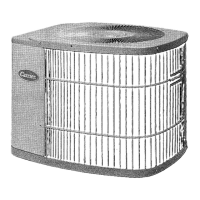REFRIGERANT TUBING AND FILTER DRIER
Installation of filter drier in liquid line is required.
Connect vapor tubing to fittings on outdoor unit vapor service
valve. Connect liquid tubing to filter drier (See Table 1 and Fig. 9.)
Use refrigerant grade tubing. Connect other end of filter drier to
adapter tube on liquid service valve.
SWEAT CONNECTION
To avoid valve damage while brazing, service valves must be
wrapped in a heat-sinking material such as a wet cloth.
Wrap service valves and filter drier with a wet cloth or heat-
sinking material. Braze connections using either silver bearing or
non-silver bearing brazing material. Do not use soft solder
(materials which melt below 800°F). Consult local code require-
ments.
LEAK CHECKING
Leak test all joints in indoor, outdoor, and refrigerant tubing.
EVACUATE REFRIGERANT TUBING AND INDOOR COIL
Never use the system compressor as a vacuum pump.
Refrigerant tubes and indoor coil must be evacuated using the
recommended deep vacuum method of 500 microns. The alternate
triple evacuation method may be used if the procedure outlined
below is followed.
IMPORTANT: Never open system under vacuum to atmosphere
without first breaking it open with nitrogen.
Deep Vacuum Method
The deep vacuum method requires a vacuum pump capable of
pulling a vacuum of 500 microns and a vacuum gage capable of
accurately measuring this vacuum depth. The deep vacuum
method is the most positive way of assuring a system is free of air
and liquid water. (See Fig. 10.)
Triple Evacuation Method
The triple evacuation method should only be used when vacuum
pump is only capable of pumping down to 28 in. of mercury
vacuum and system does not contain any liquid water. Refer to
Fig. 11 and proceed is as follows:
1. Pump system down to 28 in. of mercury and allow pump to
continue operating for an additional 15 minutes.
2. Close service valves and shut off vacuum pump.
3. Connect a nitrogen cylinder and regulator to system and open
until system pressure is 2 psig.
4. Close service valve and allow system to stand for 1 hr. During
this time, dry nitrogen will be able to diffuse throughout the
system absorbing moisture.
5. Repeat this procedure as indicated in Fig. 11. System will then
contain minimal amounts of contaminants and water vapor.
FINAL TUBING CHECK
IMPORTANT: Check to be certain factory tubing on both indoor
and outdoor unit has not shifted during shipment. Ensure tubes are
not rubbing against each other or any sheet metal. Pay close
attention to feeder tubes, making sure wire ties on feeder tubes are
secure and tight.
Fig. 8—Liquid Service Valve with Sweat Adapter
Tube
A97556
SWEAT/FLARE
ADAPTER
TEFLON
SEAL
PISTON BODY
LIQUID SERVICE VALVE
PISTON
Fig. 9—Filter Drier with Sweat Adapter Tube and
Liquid Tube
A97555
R
-
4
1
0
A
LIQUID
SERVICE
VALVE
LIQUID-LINE
FILTER-DRIER
Fig. 10—Deep Vacuum Graph
A95424
500
MINUTES
01234567
1000
1500
LEAK IN
SYSTEM
VACUUM TIGHT
TOO WET
TIGHT
DRY SYSTEM
2000
MICRONS
2500
3000
3500
4000
4500
5000
5

